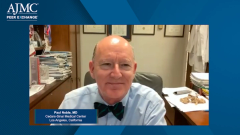
Conditional Recommendation of Nintedanib and Use in ILD Treatment
Nintedanib recommendations for use from the recent ATS guidelines and treatment implementation are considered by Paul Noble, MD.
Episodes in this series

Paul Noble, MD: If you look at patients who have progressive pulmonary fibrosis, connective tissue disease–related fibrotic lung disease, and hypersensitivity pneumonitis, where it’s believed there’s an inciting agent, with autoimmune diseases, we don’t know exactly what inciting agent or combination of environment and genetic effects lead to the immune system recognizing the lung as foreign and trying to reject it. For whatever reason, the immune response to inhaled antigens, such as molds or bird feathers, leads to this persistent stimulus, which leads to fibrosis.
Most of the time, we first try to target the underlying disease process with judicious immunosuppressive therapy in both of these conditions. Despite our best efforts, perhaps a third of the time, patients will behave clinically like they have idiopathic pulmonary fibrosis [IPF]. It’s an inexorable progression: lung function progressively declines over time. All patients with IPF will progress, but we never know what that rate of decline will be in an individual. It’s very reasonable to treat patients with an underlying connective tissue disease or hypersensitivity pneumonitis with immunosuppressive therapy because the goal is to try to make them better.
Rarely—not as often as we’d like—we can see improvement in lung function and sometimes dramatic improvements in the CT scan. One concern that I’ve had with nintedanib being approved to treat progressive pulmonary fibrosis is that patients won’t necessarily get the treatment option to target the underlying disease before nintedanib is added. There aren’t any data to suggest that patients are going to get better on nintedanib, so I always like to try to first give them that opportunity to show improvement. If they progress, then it’s very reasonable to add in nintedanib or pirfenidone. The critical factor is how we decide when to do that.
I typically see my patients every 3 months. I do lung function testing and a 6-min-walk test. If I see improvement, then I’m thrilled, and I figure out how long I’m going to need to keep them on immunosuppressive therapy. But if they progress, then I’ll look to add in an antifibrotic. Because in effect they’re behaving clinically just like IPF, so I tend to think of them as more of a patient with IPF for consideration of nintedanib or pirfenidone.
We have a pretty extensive data set for nintedanib in fibrotic lung disease. It has been remarkably consistent. I have marveled that every trial has shown a very consistent decline in forced vital capacity [FVC] in the placebo group. It has been remarkable good fortune along those lines. All the studies have shown the same thing. The greatest magnitude of difference was with idiopathic pulmonary fibrosis. Patients with IPF tend to lose about 200 mL of forced vital capacity over the course of a year, and that was reduced in half. With progressive pulmonary fibrosis and scleroderma-related fibrotic lung disease, the loss in FVC at 1 year was less, but the rate of decline was reduced in half. We have a pretty good sense of what that is.
Unfortunately, a lot of patients don’t tolerate nintedanib. There’s a big push for drugs with a similar efficacy but better tolerability to be developed, where people don’t get better but they decline at a slower rate. I’d like to see the community striving for a higher bar than that. If you look at the cystic fibrosis world, the FDA approved medications that target protein folding and the genetic underlying defect. I’m not a cystic fibrosis doctor, but looking at the FEV1 [forced expiratory volume in the first second of expiration], I said, “It didn’t change that much.” But the critical point was that it went up. As we look back years later, the number of patients who undergo lung transplant for cystic fibrosis has dropped dramatically. My patients with IPF still need lung transplants or they succumb to the disease.
I’m hoping that newer research that targets the underlying mechanism in IPF rather than the more later sequelae of collagen deposition will potentially lead to combination therapy that would include medications like nintedanib and pirfenidone but have another approach that would potentially treat the underlying abnormality in these failing alveolar type 2 cells, to see patients not need a lung transplant, live longer, and have an improved quality of life. But we aren’t there in the fibrotic lung disease world.
Transcript edited for clarity.
Newsletter
Stay ahead of policy, cost, and value—subscribe to AJMC for expert insights at the intersection of clinical care and health economics.









































